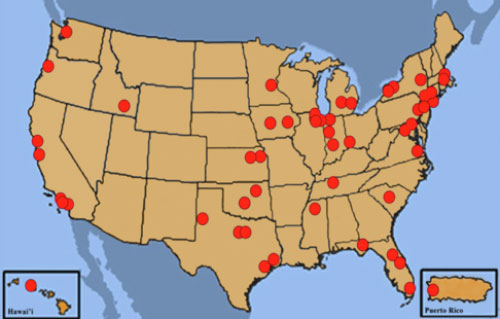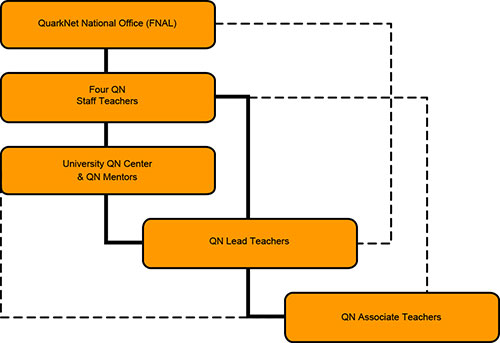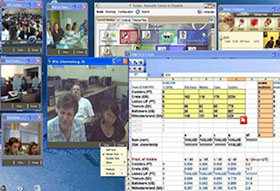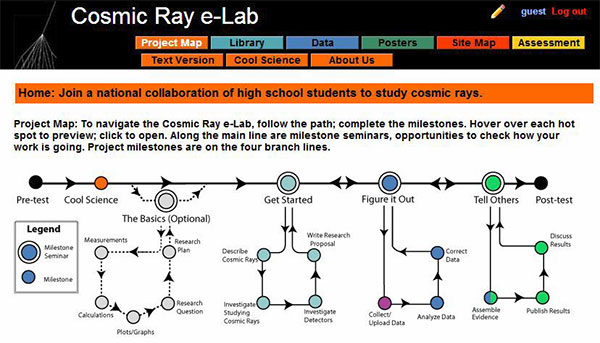QuarkNet in the Teen Years
Jon Anderson
Shane Wood
I. Introduction
Professional development is a two-word phrase that doesn't always inspire enthusiastic response or participation from high school teachers. Unfortunately, this is based on experience. The opportunity to participate in meaningful, applicable, and up-todate opportunities for professional development in one's teaching area is often difficult to locate and/or be selected to participate. Furthermore, teachers are constrained by a work schedule that is both unique to the profession and complicates the effort to seek out such opportunities. Yet, x number of professional development hours are required annually for every teacher to maintain and renew their teaching license. Consequently, participating in professional development often becomes more chore than opportunity and is often a "packaged", stand-alone workshop that offers little to no continuing support.
Physics teachers are fortunate when it comes to professional development due to the many well-supported and diverse opportunities available to them. Workshops and sessions at AAPT Summer Meetings, Research Explorations for Teachers programs at universities, physics modeling workshops, topic-specific workshops, NASA sponsored workshops, and state and local organizations of physics teachers are just a few of the options available to physics teachers in their quest for professional development. Additionally, these opportunities tend to attract motivated and knowledgeable participants and this further enhances the experience. Consequently for physics teachers, participating in professional development is usually more opportunity than chore. Two of the hallmarks of meaningful professional development opportunities are longevity and the networks of participants that develop. It is these two areas that truly set the QuarkNet collaboration apart from so many others.
II. QuarkNet History and Structure

QuarkNet Center Locations across the United States
QuarkNet was born in 1999 and is jointly funded by the National Science Foundation and the Department of Energy. From birth to its pre-teen years, QuarkNet centers were established at universities that had physicists collaborating on the CDF or D0 experiments at the Fermi National Accelerator Laboratory's Tevatron accelerator. In fact, Fermilab is still the epicenter of the QuarkNet collaboration. It has since expanded to include physicists participating in the ATLAS and CMS experiments at the Large Hadron Collider at CERN.
Now in its teen years, QuarkNet has established over 50 centers at universities across the nation and Puerto Rico as is shown on the map. It is at these centers that the participating physicists take on the role of QuarkNet Mentor. It is also at these centers that the QuarkNet workshops are held. Workshops at the centers take on a variety of different structures and we will discuss some of these later in this article.
In addition to the QuarkNet Mentor(s), each QuarkNet center selects and employs two Lead Teachers who are chosen from local schools. After training, the teachers and their mentors work together to plan the QuarkNet workshops that are held at the centers. The organizational chart that is shown above gives a generalized overview of the QuarkNet collaboration. The four Staff Teachers are employed full-time by the collaboration and provide various types of leadership and support for the QuarkNet Centers. Additionally, the dashed lines are drawn to indicate that collaboration occurs between the different layers and to illustrate that the organization does not operate in a hierarchical manner. The ongoing discussion and collaboration that this organizational structure promotes is truly one of its strengths.
During the first year for a new QuarkNet center, the lead teachers engage in a paid, eight-week summer research appointment working with their QuarkNet mentor to gain a better understanding of the concepts and research involved. The first week of this appointment is spent at Fermilab as participants in Boot Camp. This is an activity that will be discussed in more detail later in this article. The lead teachers then take the knowledge and experience that they gained from the research appointment and incorporate it into their curriculum as well as beginning the planning process for subsequent summer workshops.

QuarkNet Organizational Structure
III. QuarkNet Professional Development Opportunities
The QuarkNet collaboration and the activities that are developed for professional development are driven by four goals.- QuarkNet teachers provide opportunities for students to increase their scientific proficiency, especially in particle physics.
- QuarkNet teachers create environments for students to interpret, evaluate and provide explanations for phenomena in the natural world.
- Students of QuarkNet teachers show evidence that they understand how scientific knowledge is developed and engage in scientific practices and discourse.
- QuarkNet teachers participate in sustained professional development. The QuarkNet professional development opportunities that support these goals are numerous. Some of the most important are discussed below.
A. Particle Physics Boot Camp
As the name implies, the annual particle physics "Boot Camp" is a chance for new lead teachers and other QuarkNet teachers to immerse themselves in a week-long, intensive particle physics experience at Fermilab. Participants experience a guided inquiry data analysis activity in which they gain a better understanding of what happens in collider detectors. Several of the physics concepts that the teachers apply in their analyses are among the very concepts that are taught in high school physics, including the use of vectors, conservation of energy and conservation of momentum. Teams work collaboratively, guided by QuarkNet staff members and other QuarkNet teachers (QuarkNet Fellows). The week concludes with participants presenting results in a poster session at Fermilab. The Boot Camp week also includes many facility tours, physicist talks, and time for teachers to discuss and reflect on pedagogy.
B. High School Teachers (HST) at CERN
Each summer, a number of QuarkNet teachers are chosen from the United States to attend the High School Teachers program at CERN. This international program takes place for three weeks each summer, and includes physics teachers from around the world. Goals of this program include the promotion of physics and particle physics education in high schools, to expose teachers to particle physics research, to create, update and modify particle physics-related activities to be used in the classroom, and to provide a setting that encourages the exchange of ideas and experiences among an international collection of teachers. Curricular contributions from each year's participants continually update the wide array of particle physics teaching materials housed at the HST website. HST teaching materials produced over the years include lessons and activities focused around accelerators, detectors, bubble chambers, particle physics experiments, and physics in general.

A graduate student demonstrates a cloud chamber for students participating in a Masterclass day at the University of Minnesota.
C. QuarkNet Fellows
The QuarkNet Fellows Program began in 2007 in order to develop leadership in a select number of QuarkNet teachers who could work with QuarkNet staff in order to provide professional development activities for QuarkNet centers. Fellows develop and lead workshops, create activities to be used with teachers and students, attend and present at national, regional, and local conferences. Particle physics Boot Camp, the US Masterclass, cosmic ray workshops, and LHC data workshops are among the many facets of QuarkNet in which the Fellows play a key role.
D. Ongoing Local Professional Development
In addition to some of the national and international programs and initiatives mentioned above, networks of QuarkNet teachers are active each year at the 50+ local QuarkNet centers scattered across the United States. QuarkNet Mentors and Lead Teachers, in collaboration with QuarkNet staff members coordinate a wide variety of professional development activities at each center. Examples include cosmic ray and LHC data workshops led by QuarkNet Fellows and staff, talks by particle physicists regarding the latest developments in particle physics research, building equipment that can be used in the classroom (including cloud chambers and cosmic ray detectors), time for discussion regarding state and local standards, facility tours, demonstration shows, among many other activities and events. Each year, many centers bring on new teachers to the network, while providing continuing opportunities for the experienced QuarkNet teachers.
IV. QuarkNet Mentor and Teacher-Led Opportunities for Students

QuarkNet teachers study a particle detector (cloud chamber) up close during a QuarkNet meeting.
A. The Particle Physics Masterclass
Each year since 2007, QuarkNet has organized the US Masterclasses in which high school physics students have the opportunity to work for a day with QuarkNet teachers and mentors at local QuarkNet centers. The day includes particle physics talks, facility tours, lunch with a physicist, demonstrations (including cloud chambers, e/m apparatus, etc.), Q&A sessions, and culminates with students at each center analyzing 1000 events from various particle physics experiments (including data from the ATLAS and CMS detectors at CERN). Modeled after the world of professional physicists, students communicate results with one another through videoconferences, where results are summarized, questions are asked, and implications discussed. Prior to the Masterclass day, QuarkNet teachers must "set the stage" for participating students by working through three-plus hours of preparation materials. Masterclass provides opportunities for students to apply physics concepts learned in physics class (conservation laws, etc.) to modern physics research, to build their knowledge of particle physics concepts, and to deepen their understanding of the nature of science.

Participants in a Masterclass communicate through a video conference.
B. Interactions in Understanding the Universe (I2U2) e-Labs
QuarkNet teachers and their students now utilize various "e- Labs" in order to conduct authentic research experiences and to participate in scientific collaborations that extend beyond the classroom. The e-Labs are created and maintained by the organization I2U2 (Interactions in Understanding the Universe), and provide a common framework and resources for studentled, teacher-guided investigations. Students access e-Labs through a web-browser where they are guided through various milestones that include planning research, collecting/analyzing data, and publishing results in an online poster format. Students record progress and obtain teacher guidance through the use of an online logbook that allows for teacher feedback. Students currently have access to three types of e-Labs, including CMS (CERN's Compact Muon Solenoid), LIGO (Laser Interferometer Gravitational-wave Observatory) and cosmic ray e-Labs. Much of the data uploaded for the cosmic ray e-Labs originates from QuarkNet-issued, student-assembled cosmic ray detectors located at high schools scattered around the country.
 The opening web page indicating a research path for students to take in a Cosmic Ray e-Lab.
The opening web page indicating a research path for students to take in a Cosmic Ray e-Lab.C. Summer Teacher/Student Research Program
Since 2004, QuarkNet has supported a summer student research program in which teams of four high school students work with a QuarkNet teacher on one of a variety of research topics. To date, research has been associated with variety of experiments, including CERN's ATLAS and CMS detectors, and cosmic ray muon detectors located in classrooms. The program runs for six weeks each year out of several QuarkNet centers around the country.
V. QuarkNet at the University of Minnesota
The QuarkNet center at the University of Minnesota (U of MN) got its start in 2002 with the support of QuarkNet Mentors Dr. Kenneth Heller and Dr. Priscilla Cushman. Dr. Daniel Cronin-Hennessey has since replaced Dr. Cushman as one of the mentors. In 2002, the authors were hired as Lead Teachers. Our initial training and research appointments started with one week of Boot Camp at Fermilab. This was followed by participating in research with the mentors at the University of Minnesota and at CERN. It was an exciting summer with a steep learning curve! As per the QuarkNet model, we spent the next academic year implementing what we had learned as well as planning for the three week workshop for Minnesota physics teachers to be held in the summer of 2003. Since that initial QuarkNet workshop, we have been conducting five to six day workshops every summer. Our workshop model is focused on exposing and introducing physics and physical science teachers from Minnesota to particle physics background material, particle physics-related curriculum, and to the larger QuarkNet collaboration. We have had over 100 teachers participate in our workshops and they bring a wide variety of backgrounds to our center.- The teaching experience of participants has ranged from recent graduates of licensure programs to master teachers with 34 years in the classroom.
- Some participants have extensive physics background and coursework while others have had only one or two courses in physics.
- Some participants teach in rural schools while some teach in urban high schools.
- Some participants teach only physics classes while others are THE science teacher, teaching physics, chemistry, and biology.
Our workshops are a mix of "Particle Physics 101", working with particle physics-related labs and curriculum, lunch talks by U of MN particle physicists, introduction to the Masterclass, and tours of particle physics research facilities. We have toured research laboratories on the U of MN campus, the NOnA experiment detector module factory, the MINOS experiment, and Fermilab.
Being a physics teacher is often a lonely pursuit. It is not unusual to be the only physics teacher at a school so collaboration with peers is rare. Perhaps the most significant accomplishment of our QuarkNet center is that we have been able to facilitate the creation of a community of physics teachers. These teachers are connected to one another, they are connected to QuarkNet, they have taken advantage of additional QuarkNet professional development opportunities, they are more knowledgeable about particle physics topics and activities, they have engaged countless students in the inquiry process that is physics research, and they have successfully advanced the scientific literacy of their students through their connections to this larger community. This accomplishment is not unique to our center; other QuarkNet centers have been equally successful.
VI. Conclusion
QuarkNet is now 14. As it starts its 15th year, it starts with another five years of funding. This funding will allow it to continue to grow, mature, and reach adulthood as a vital component of and contributing member to the physics teaching professional development society. This is unusual in the realm of professional development opportunities.
In the last 14 years, there have been numerous people and institutions involved in the raising of QuarkNet. All of these have had their own impacts on QuarkNet and all have had a hand in easing the growing pains that are inevitable in this process. Along the way, QuarkNet has been able to learn, to adapt, and to become a stronger collaboration as a result of the type of input that has been provided. It is this continual growth that has allowed the QuarkNet collaboration to provide up-to-date and classroom-ready curricular materials and background information as key parts of workshops at QuarkNet centers across the country. Because of this growth, the Masterclass continues to improve and continues to immerse a broader populace in the excitement and challenge of basic research, scientific literacy continues to grow, the QuarkNet centers continue to evolve based on the resources of the centers and the needs of the teachers they serve. Unique collaborations of physicists, postdocs, technical staff, graduate and undergraduate students, high school teachers and high school students continue to be formed. Perhaps most importantly, the high school teachers being served and the students with whom they do and will work continue to be the biggest beneficiaries of QuarkNet.
Jon Anderson has taught physics at Centennial High School near Minneapolis since 1988. He was the TIR at the University of MN PhysTEC site from 2007-2009, continues to work as a consultant for the PhysTEC project, and has been a QuarkNet Fellow since 2007.
Shane Wood has been a science teacher at Irondale High School near Minneapolis, MN since 2001. He has been involved in QuarkNet since 2002, and a QuarkNet Fellow since 2007.
Disclaimer–The articles and opinion pieces found in this issue of the APS Forum on Education Newsletter are not peer refereed and represent solely the views of the authors and not necessarily the views of the APS.
